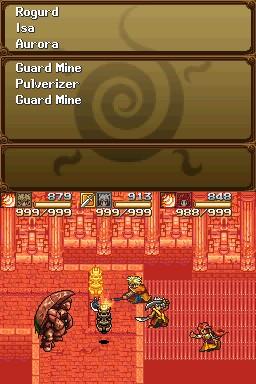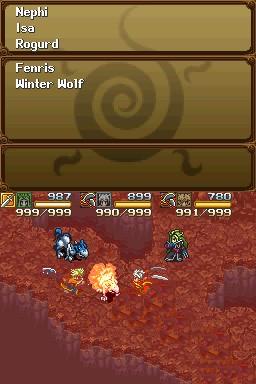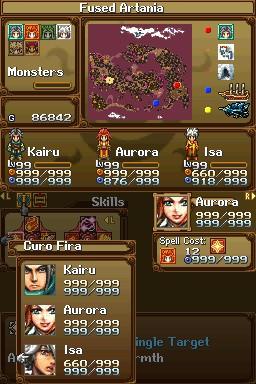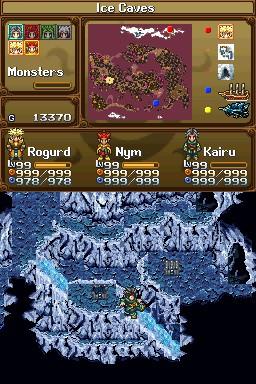
White Knight Chronicles Review
White Knight Chronicles is Level-5's debut on the Playstation 3 after a very successful run on the Playstation 2 and Nintendo DS with strong RPG titles like Dark Cloud, Rogue Galaxy, and the immensely successful logic and puzzle based Professor Layton series.
The transfer to the high-definition generation has proved problematic for even the strongest and best-funded of developers, but given their handsome pedigree in the past, expectations have been high for Level 5's PS3 debut. Interestingly, Level 5 have chosen to eschew many RPG traditions and attempt to use an element of the machine not available on the PS2 - the online connectivity.
White Knight Chronicles offers two distinct modes, a traditional single-player adventure as well as a fully-featured online mode that is best left compared to Sega's Phantasy Star Online series. Before we get into all that, let's start with the core of any Japanese RPG - the story.

White Knight Chronicles starts off in the kingdom of Balandor, where the aging king has invited the duke of Faria to his daughter Cessna’s coming-of-age ceremony. This isn't all happy, though – Faria and Balandor have been feuding and warring for an age, and the invitation is extended in an attempt to try to end the war once and for all.
It’s all looking rosy until a band of rogues calling themselves the Magi crash the party and attempt to steal away the princess – a classic RPG opening.
A young man named Leonard tries to save the princess, taking her down to the castle cellars. In the cellars he comes across an ancient weapon known as the White Knight. Leonard finds himself able to control the gigantic suit of armor and mows down the Magi enemies with ease. Despite Leonard’s newfound power the Magi manage to grab the princess anyway – and thus the adventure begins, with Leonard recruiting a band of heroes to chase after the princess, rescue her and of course stop a potentially world-ending plot.
The cast consists largely of many of the traditional RPG clichés found in titles coming out of Japan – there’s Yulie, a childhood friend of Leonard, Eldore, a skilled warrior who has travelled through time to find the reincarnation of a queen he once served and a bunch of other allies as well as Dregias, the leader of the Magi who can transform into the Black Knight Ebonwings and Cessna, the captured young princess who of course is the key to a mysterious power.
The story is rather paper-thin in nature and ultimately forgettable. There is nothing here that you haven’t seen before, and the pacing can drag down and become rather monotonous a large part of the time. The characters are bland, the visuals are bland, and the environments, impressive in scale as they are, feel largely uninspired.

After the linear world of Final Fantasy XIII one feels as though they should be grateful for a Japanese RPG that actually offers towns and cities to explore littered with people who mostly have interesting things to say, though White Knight Chronicles somehow makes these places lack in atmosphere and feel mind-numbingly tedious – making an argument for Final Fantasy’s trend towards linearity.
The main quest of White Knight Chronicles can be polished off in around 20 hours and it really isn’t spoiling anything to say that the game ends in such a manner that leaves the game open for a sequel. Thanks to the incredibly long localization time that sequel has already been announced and hits this summer over in Japan.
The existence of that cliff-hanger and the sequel's ever-looming release helps to underline the fact that there is an awful lot of unrealized potential in White Knight Chronicles. It almost feels like Level 5 knew they had a long way to go before that full potential could be realized but they also knew they had to ship a game to keep those in charge happy - and so what we get here is the best that could be mustered, with the sequel set to resemble the full vision of the developers.
Factor in how heavily this game has been patched over in Japan since its release to add significant new features such as voice chat and the game suddenly feels like it was released in an incomplete state, and even this expanded 'International' edition feels lacking.
It’s all difficult to describe, but in a way White Knight Chronicles doesn’t feel like a high-definition, next-generation title. It was an early PS3 title over in Japan and that age now shows, with the game not only lacking in the visual department compared to something like Final Fantasy XIII or Star Ocean 4 but the overall presentation of the game ends up feeling an awful lot like a PS2 title. It’s almost like Level 5 have struggled to take that definitive step forward with their overall presentation and design.
While the story and design leaves much to be desired from a top-tier PS3 title from a major JRPG powerhouse, the gameplay is solid. It sports an MMO-style HUD that I found most reminiscent of Final Fantasy XI, and the enemies are encountered on the field with a seamless transition into battle much like the aforementioned game and its direct sequel Final Fantasy XII.

The massive areas and seamless transition into battle go a great way to contributing to giving the game a decent amount of scope in spite of it's relatively standard graphics.
There's no turns in the traditional sense, but you'll have to wait for action meters to recharge before you can execute attacks. While you can only control one party member, basic commands can also be issued to other members of your party as well. The worst part of the battle system comes in the form of waiting for characters to recharge their moves - I'd be hammering X waiting for that charge meter to fill.
It all feels very familiar and similar to Japanese RPGs already out there with some significant little twists. The largest twist of all comes in the form of the titular White Knight, a gigantic suit of armor that is essentially this game's Limit Break or special attack. It's fun and satisfying to use, though in certain situations it can come across as utterly skilless.
Character progression is decently open-ended, and offers a massive amount of opportunities to decide how to develop each playable party member into a plethora of potential roles. Progression in different roles unlocks different combos, offensive attacks and defensive abilities, all of which will be handy in different situations.
The sound design is definitely one of the best elements in the game. The orchestral music is beautifully epic in nature, and while the characters are pretty bland in their design the voice acting is well-produced, directed and acted, though the lip sync hasn’t been redone, leaving it slightly off-sync sometimes. Considering this is called the ‘International Edition’ I was slightly disappointed that the Japanese voice track is absent, but that isn’t something that I’d get hung-up on.
Like many other RPGs of late, characters can talk on the field to add a little flavour and characterization to regular running around. It’s a mixed bag – sometimes it adds to the atmosphere of a scene, but other times I find myself wanting to wrap my hands around that person's neck. Usually that’s Yulie telling me to slow down or asking me whether we had already been that way before (very rarely was she right). Leonard can also get a little weird with his borderline-creepy obsession with the princess. The good thing is that the game offers the ability to turn the conversations off in the Options menu. Thank you, Level-5! Repetitive small talk is the bane of my existence.

You might notice that I’ve been referring to Leonard – technically the lead – by his name, and not as the player character. That’s because despite being the lead character he isn’t who you actually play as. You’ll actually be tasked with designing a custom character before you start the game, and that character creation is where my biggest issue with this game lies.
Scene after scene goes by where you completely lose sight of your created character with Leonard pushed to the front-and-centre doing all the cool things and saving all the beautiful women I had planned on doing when I spent over an hour creating my first character. But no, every time I see an 18 minute cut scene, my character appears in the last 15 seconds with absolutely no lines and acting more like a damsel in distress than someone I was going to take pride in.
Sometimes a character or two will throw a glance in your direction but for the most part you're usually seen hanging out in the background picking dandelions and wondering what it would be like to be a contributing member of the adventure who isn't easily replaceable like some greeter at Wal-Mart. I found myself playing Leonard for most of the game and just letting my created character play back up to keep the enemies off of me while I transformed into the White Knight.
How am I supposed to associate myself with Leonard as the main character when the game just gave me the middle finger for putting all that time and effort into my created character? I feel like I am having some sort of out-of-body experience, and in the end the feature feels incredibly forced, as this mute player-created character really exists to be your avatar once you head into the game’s online mode – but more on that later.
It’s a great shame that this game boasts of having a robust character creator allowing for player customization – a feature rare in Japanese RPGs – but actually utterly fails to live up to this promise. I’m happy they will be taking this into account when they release White Knight Chronicles 2 where your created character will actually be the main protagonist, but honestly, this should have never been an issue in the first place.
Fortunately, you can take your created character into the online mode GeoNet (accessible from either the World Hope or a Save Point), where you really do become the protagonist. GeoNet allows players to create their own "homepages" where they can do things like customize the look of their created towns, start chat rooms to talk with friends about a variety of topics, make a blog post or look at what others have made, see your friends (which isn't tied to your PSN friends, since they have to be added separately), and even jump on the message board. Think of it like a virtual Facebook.

The town you create using GeoNet can be as big or as small as you want it to be and offers a very pleasing amount of variety and options. When visiting the Papitaur Workshop in this mode, you are able to create items and buildings you can put in your town using the materials you find along your journey in the single player mode.
You are also able to recruit a lot of different residents in the game (signified by their colored names) to come to your own and take over a lot of the different tasks and skill trades, such as Farmer, Miner, Chef, etc. It takes a little getting used to, but once you do get the hang of it, it can be pretty entertaining to have this sort of feature in an online mode.
It feels like a mish-mash of RPG and management elements, and while I’m intending to spend more time with it than I have already I’m quite happy to say that it reminded me a lot of the Geo system from Dark Cloud, which was a heck of a lot of fun to toy around with.
Most of all, it made me pine even more for Level 5 to continue developing True Fantasy Live Online, their now-cancelled MMORPG collaboration with Microsoft from the original Xbox days. Some of the ideas here may be leftovers from True Fantasy Live, and they’re certainly some of the stronger, cooler and more original ideas expressed in White Knight Chronicles.
As far as actual online questing goes, once inside the game you find yourself in a "lobby" of sorts with other players where you can either hang around and chat and emote your ass off or join together on a quest of up to 4 people much like Sega’s semi-MMO Phantasy Star Online.
The quests can be bought from the Adventurer's Guild in the game and range greatly in difficulty and rewards, and you are able to see if you meet the level requirements that the quest calls for. It is a very cool feature, and you share the items and experience points you gain from the quest itself between the users who participate in it.
I personally tend to play RPGs for the single player experience, so much of this fairly robust online multiplayer experience was lost on me, but at the same time I can absolutely see what Level 5 was aiming for with the online features of White Knight Chronicles, which go some way to try to bridge the gap between single and multiplayer RPG experiences.
Ultimately the worst thing about the online aspects of White Knight Chronicles is that it has had an adverse effect on the single-player adventure. The player-created character – ultimately an avatar for online – is forced into the single player experience and the MMO-style combat – perfect for online – doesn’t quite feel right in the single player adventure.

White Knight Chronicles looks from the outside to be a traditional Japanese RPG. It promises to be powerful and epic with a great storyline, compelling characters and beautiful environments all wrapped together with a moving orchestral score. While White Knight Chronicles does include healthy doses of all of these ultimately the muddied vision of what the game is – part MMO, part single player, part turn based, part action RPG – blur the overall end product, faltering and falling short of being something far greater.
White Knight Chronicles isn’t quite the sum of its parts – it has a solid combat system, pretty world design and an intriguing take on online for a Japanese RPG, but all these parts don’t quite meld together right and other elements such as the character design and integration of the player character leave much to be desired.
It’s a solid game and presents interesting new ideas, and for that alone it deserves an above-average score, but players should go into White Knight Chronicles well-aware that while they may be taking an early glimpse at one potential online-infused future for the JRPG genre, this future has a heck of a long way to go before it’s ready to create a classic.
I hope that they will be able to accomplish this and more when the sequel comes out this summer in Japan, but for now, this does not really seem like the type of game that I would want to keep coming back to again and again like some of the other classics from Level 5 – especially the Dark Cloud sagas.
The best I can give this game is an above-average score, but that's because Level-5 has a calibre all of its own that shines through even in this flawed attempt to move the genre forward. Here’s hoping the sequel addresses those issues.
P.S. Just an editor's note, but here's to hoping Level-5 takes full advantage of their new partnership with Studio Ghibli to bring a game to the PS3. Now how cool would that be?